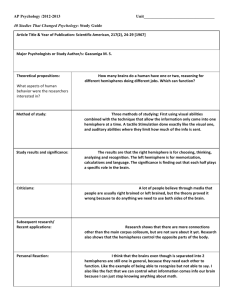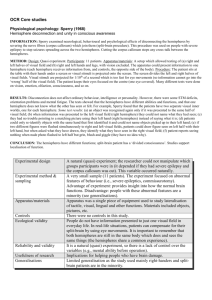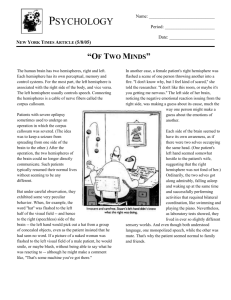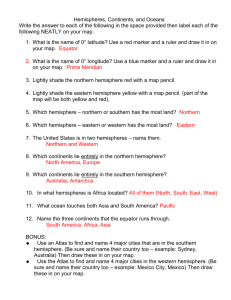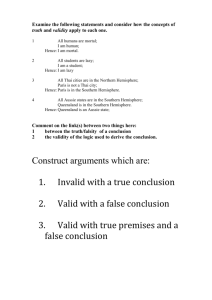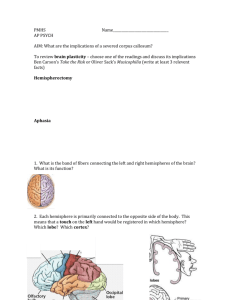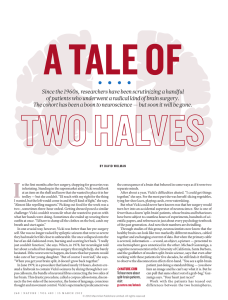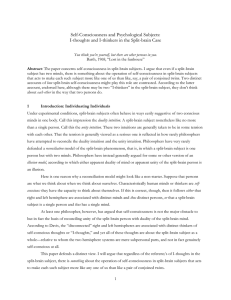Behavior of Split Brain Patients
advertisement
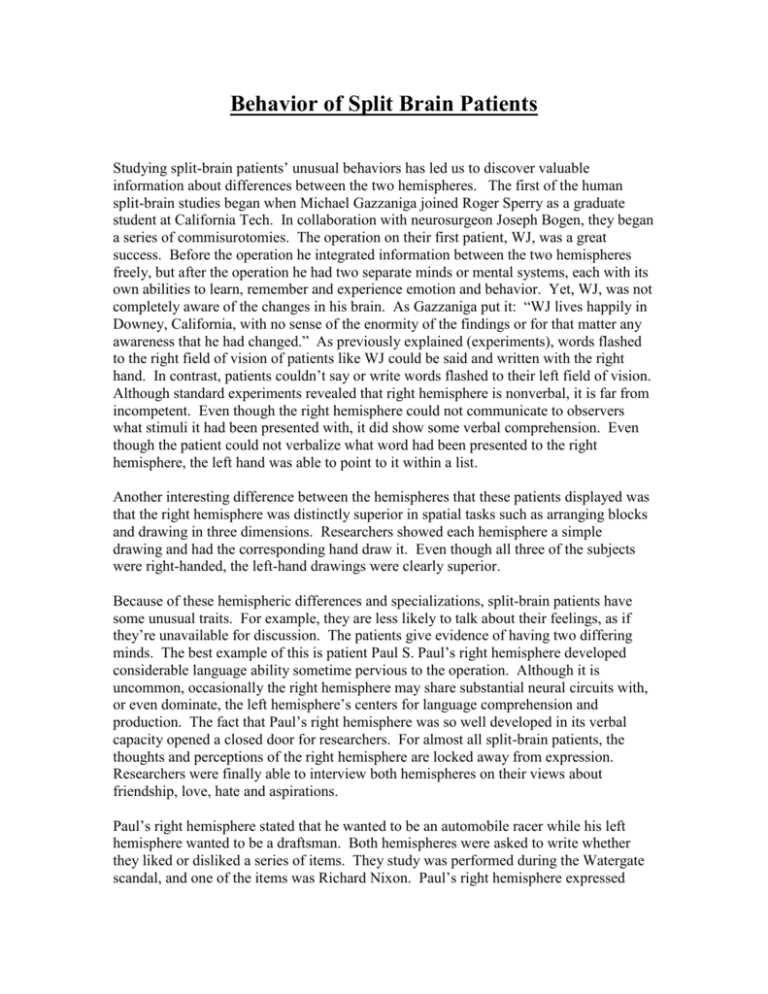
Behavior of Split Brain Patients Studying split-brain patients’ unusual behaviors has led us to discover valuable information about differences between the two hemispheres. The first of the human split-brain studies began when Michael Gazzaniga joined Roger Sperry as a graduate student at California Tech. In collaboration with neurosurgeon Joseph Bogen, they began a series of commisurotomies. The operation on their first patient, WJ, was a great success. Before the operation he integrated information between the two hemispheres freely, but after the operation he had two separate minds or mental systems, each with its own abilities to learn, remember and experience emotion and behavior. Yet, WJ, was not completely aware of the changes in his brain. As Gazzaniga put it: “WJ lives happily in Downey, California, with no sense of the enormity of the findings or for that matter any awareness that he had changed.” As previously explained (experiments), words flashed to the right field of vision of patients like WJ could be said and written with the right hand. In contrast, patients couldn’t say or write words flashed to their left field of vision. Although standard experiments revealed that right hemisphere is nonverbal, it is far from incompetent. Even though the right hemisphere could not communicate to observers what stimuli it had been presented with, it did show some verbal comprehension. Even though the patient could not verbalize what word had been presented to the right hemisphere, the left hand was able to point to it within a list. Another interesting difference between the hemispheres that these patients displayed was that the right hemisphere was distinctly superior in spatial tasks such as arranging blocks and drawing in three dimensions. Researchers showed each hemisphere a simple drawing and had the corresponding hand draw it. Even though all three of the subjects were right-handed, the left-hand drawings were clearly superior. Because of these hemispheric differences and specializations, split-brain patients have some unusual traits. For example, they are less likely to talk about their feelings, as if they’re unavailable for discussion. The patients give evidence of having two differing minds. The best example of this is patient Paul S. Paul’s right hemisphere developed considerable language ability sometime pervious to the operation. Although it is uncommon, occasionally the right hemisphere may share substantial neural circuits with, or even dominate, the left hemisphere’s centers for language comprehension and production. The fact that Paul’s right hemisphere was so well developed in its verbal capacity opened a closed door for researchers. For almost all split-brain patients, the thoughts and perceptions of the right hemisphere are locked away from expression. Researchers were finally able to interview both hemispheres on their views about friendship, love, hate and aspirations. Paul’s right hemisphere stated that he wanted to be an automobile racer while his left hemisphere wanted to be a draftsman. Both hemispheres were asked to write whether they liked or disliked a series of items. They study was performed during the Watergate scandal, and one of the items was Richard Nixon. Paul’s right hemisphere expressed “dislike,” while his left expressed “like.” Most split-brain patients would not be able to express the opinions of the right hemispheres as Paul S. did, but this gives us insight on the hidden differences between the hemispheres. These hidden differences are allowed to demonstrate themselves after a split-brain operation because the two hemispheres are closer to existing independently. One hemisphere may not be able to suppress or influence differing opinions, emotions, or desires of the other because most of the communication between the two can no longer occur. As a result, conflicting hemispheric desires or opinions can cause split-brain patients to exhibit some strange behaviors. One patient found his left had struggling against his right hand when trying to pull up his pants in the mornings. While the right hand tried to pull them up, the left was trying to pull them down. On another occasion, he was angry with his wife and attacked her with is left hand while simultaneously trying to protect her with his right! Split-brain patients also have taught us about dreaming. Scientists had hypothesized that dreaming is a right hemisphere activity, but they found the split-brain patients do report dreaming. They found, therefore, that the left hemisphere must have some access to dream material. What was most interesting was the actual content of the dreams of the split-brain patients. Klaus Hoppe, a psychoanalyst, analyzed the dreams of twelve patients. He found that the dreams were not like the dreams of most normal people. “The content of the dreams reflected reality, affect, and drives, even in the more elaborate dream, there was a remarkable lack of distortion of latent dream thoughts. The findings show that the left hemisphere alone is able to produce dreams…Patients after commisurotomy reveal a paucity for dreams, fantasies, and symbols. Their dreams lack the characteristics of dream work; their fantasies are unimaginative, utilitarian, and tied to reality; their symbolizing is concretistic, discursive, and rigid.” These studies of abnormalities of split-brain patients as opposed to normal people are providing much insight on hemispheric specialization.
